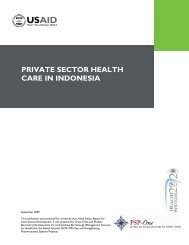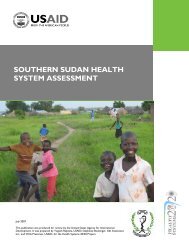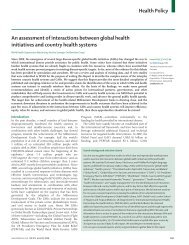Case Study on Piloting Complex Health Reforms in ... - PHRplus
Case Study on Piloting Complex Health Reforms in ... - PHRplus
Case Study on Piloting Complex Health Reforms in ... - PHRplus
You also want an ePaper? Increase the reach of your titles
YUMPU automatically turns print PDFs into web optimized ePapers that Google loves.
Issyk-Kul oblast piloted the s<strong>in</strong>gle-payer system <strong>in</strong> 2001. Excess capacity was rati<strong>on</strong>alized, with the<br />
number of beds be<strong>in</strong>g reduced by 32 percent, the number of build<strong>in</strong>gs reduced by 30 percent, and<br />
staff reduced by 13 percent. Staff salaries <strong>in</strong>creased by 20 percent, fund<strong>in</strong>g for patient supplies and<br />
other direct costs <strong>in</strong>creased by 116 percent, and expenditures <strong>on</strong> drugs per patient-day <strong>in</strong>creased by<br />
170 percent. Results of the s<strong>in</strong>gle-payer system pilots <strong>in</strong> Issyk-Kul and Chui oblasts c<strong>on</strong>v<strong>in</strong>ced<br />
President Askar Akaev to endorse their replicati<strong>on</strong> <strong>on</strong> October 16, 2001: “Success of the Issyk-Kul<br />
and Chui oblast pilots <strong>in</strong> implement<strong>in</strong>g new methods of health f<strong>in</strong>anc<strong>in</strong>g, <strong>in</strong>clud<strong>in</strong>g co-payment<br />
mechanisms [have] led to a sharp decrease <strong>in</strong> corrupti<strong>on</strong> <strong>in</strong> health care facilities, as well as an<br />
<strong>in</strong>crease <strong>in</strong> revenues that allow for improvements <strong>in</strong> the quality of care. These new, positively tested<br />
methods of health care organizati<strong>on</strong> should be spread countrywide.”<br />
This core structural and f<strong>in</strong>anc<strong>in</strong>g reform <strong>in</strong> the health system provides the foundati<strong>on</strong> for<br />
additi<strong>on</strong>al <strong>in</strong>terventi<strong>on</strong>s that change the behavior of stakeholders <strong>in</strong> the health system, like an<br />
outpatient drug benefit and formalized co-payments. The outpatient drug benefit has resulted <strong>in</strong> more<br />
of the populati<strong>on</strong> be<strong>in</strong>g <strong>in</strong>sured, <strong>in</strong>creased availability of drugs at FGPs, <strong>in</strong>creased utilizati<strong>on</strong> of<br />
primary health care, and reduced hospital referrals and admissi<strong>on</strong>s. Formal co-payments for<br />
specialized outpatient and <strong>in</strong>patient care have reduced <strong>in</strong>formal payments to doctors and for drugs,<br />
and significantly <strong>in</strong>creased facility resources available to improve quality of care (McEuen, 2002).<br />
Currently, the MOH is work<strong>in</strong>g to <strong>in</strong>clude c<strong>on</strong>t<strong>in</strong>ued <strong>in</strong>troducti<strong>on</strong> of the s<strong>in</strong>gle-payer system and<br />
timely transfer of funds from the Social Fund to the MHIF as c<strong>on</strong>diti<strong>on</strong>alities of upcom<strong>in</strong>g structural<br />
adjustment credits and therefore better ensure susta<strong>in</strong>ability of health f<strong>in</strong>anc<strong>in</strong>g reforms.<br />
6.4 Build<strong>in</strong>g Capacity to Implement <strong>Health</strong> Reform<br />
The management skills required to formulate and implement plans were not well developed <strong>in</strong> the<br />
Central Asian health sector, <strong>in</strong> part because the Soviet system did not put a premium <strong>on</strong> problem<br />
solv<strong>in</strong>g or risk-tak<strong>in</strong>g behavior. <strong>Health</strong> reform efforts, at pilot and nati<strong>on</strong>al levels, have been<br />
accompanied by significant <strong>in</strong>vestments <strong>in</strong> build<strong>in</strong>g capacity to implement health reform. This has<br />
occurred through tra<strong>in</strong><strong>in</strong>g, exchanges, and study tours, but perhaps most importantly through actual<br />
implementati<strong>on</strong> by counterparts together with d<strong>on</strong>ors. This approach created a health reform<br />
foundati<strong>on</strong> that made evoluti<strong>on</strong> of reforms more <strong>in</strong>evitable and relied <strong>on</strong> small successes to build<br />
c<strong>on</strong>fidence, <strong>in</strong>crease <strong>in</strong>terest, and ultimately c<strong>on</strong>tribute to big successes.<br />
It is important for Issyk-Kul to c<strong>on</strong>t<strong>in</strong>ue to stay а step ahead and serve as а visible leader and<br />
symbol to facilitate the <strong>in</strong>troducti<strong>on</strong> of health reform <strong>in</strong> other parts of the country: “A pilot never<br />
ends, there is always c<strong>on</strong>t<strong>in</strong>uous learn<strong>in</strong>g as the pilot goes deeper” (Ibraimova, 2003). Issyk-Kul<br />
oblast rema<strong>in</strong>s to this day a test site for subsequent steps <strong>in</strong> Kyrgyz health reform, such as the s<strong>in</strong>glepayer<br />
system and the <strong>in</strong>troducti<strong>on</strong> of facility-level quality improvement systems. In additi<strong>on</strong>, the<br />
M<strong>in</strong>istry of <strong>Health</strong> is test<strong>in</strong>g new models of provid<strong>in</strong>g emergency care and ambulance services <strong>in</strong><br />
Chui oblast and experiment<strong>in</strong>g with hospital restructur<strong>in</strong>g and management <strong>in</strong> Naryn oblast. In<br />
c<strong>on</strong>trast to the <strong>in</strong>itial Issyk-Kul oblast pilot, these subsequent pilots aim to test and ref<strong>in</strong>e more<br />
specific and narrow health reform <strong>in</strong>terventi<strong>on</strong>s and have been more rigorously and capably evaluated<br />
by the MOH and the MHIF, with support from WHO and other d<strong>on</strong>ors. Evaluati<strong>on</strong> and<br />
implementati<strong>on</strong> experience has led to ref<strong>in</strong>ement and phased implementati<strong>on</strong> of the s<strong>in</strong>gle-payer<br />
system and the outpatient drug benefit, as well as expansi<strong>on</strong> and roll-out of facility-level quality<br />
improvement systems.<br />
6. Pilot Outcomes 25

















